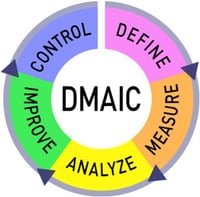 Most of the time when we talk to people about continuous improvement, the focus is on using improvement techniques to make business processes more efficient, which is obviously great. What sometimes gets missed, however, is the concept that improvement itself is a process. In order to be effective and lasting, there needs to be a structure and standard for improvement work. The DMAIC approach is a simple, yet powerful way to make your organization’s improvement efforts consistent, repeatable, and successful over the long term.
Most of the time when we talk to people about continuous improvement, the focus is on using improvement techniques to make business processes more efficient, which is obviously great. What sometimes gets missed, however, is the concept that improvement itself is a process. In order to be effective and lasting, there needs to be a structure and standard for improvement work. The DMAIC approach is a simple, yet powerful way to make your organization’s improvement efforts consistent, repeatable, and successful over the long term.
The five steps are: define, measure, analyze, improve and control.
Define
The first step is to clearly state the target business problem and delineate the scope of the improvement effort to be undertaken. It is important to document as much detail about the problem and the current state as possible. This phase also involves deciding what constitutes success. Many organizations use formal project charters to capture this information and communicate the plan.
Measure
Improvement work should have quantifiable outcomes. This means that both the baseline and the post-improvement results must be calculated so that a comparison can be made and the impact of improvement calculated. Teams should decide which key performance indicators will be used to measure success. Responsibility for measurement needs to be assigned, and the frequency of measurement determined.
Analyze
Once the data is gathered, a root-cause analysis can be conducted to uncover the underlying reason for the business problem. The 5 Whys is a valuable technique at this stage, as are process maps. Keep in mind that some problems have more than one root-cause. With the focus on causes, not symptoms, the team begins to discuss solutions and develops a plan for improvement.
Improve
Only after careful measurement and analysis are the proposed improvements implemented. It is important to communicate the improvement plan, as well as the risks and steps taken to mitigate those risks. Every improvement is an experiment, so it is crucial to pay close attention to outcomes and unintended consequences.
Control
The last step in the DMAIC process is a vital one that is, unfortunately, often missed. The goal at this stage is to make sure that successful improvements are long-lasting and don’t degrade over time. This is also the team’s opportunity to consider whether this improvement might be applied to other problems or replicated in other parts of the organization. Now is the time to finalize the Standard Work for the improved process and develop long-term measurement plans.
Process improvement can be intimidating, but as with any other complex task, if you break it down into its component parts, it becomes much more manageable. Adding the structure and consistency of DMAIC to your improvement projects will help your team reach its goals.



Add a Comment